ncnw



as we go!
While it is true that without a vision the people perish, it is doubly true that without action the people and their vision perish as well.
“Whatever glory belongs to the race for a development unprecedented in history for the given length of time, a full share belongs to the womanhood of the race.”
“Without community service, we would not have a strong quality of life. It’s important to the person who serves as well as the recipient. It’s the way in which we ourselves grow and develop.”Dr. Mary
McLeod BethuneDr. Dorothy Irene Height Dr. Johnnetta
Betsch Cole
We often speak of NCNW as an “organization of organizations.” That phrase refers to NCNW’s role as conduit of its affiliates. It is that important nexus that gives NCNW the right to say that it speaks on behalf of women of African descent, their families and communities. Nevertheless, that phrase does not fully describe all of the constituencies that make up the NCNW family.
In addition to the 32 national women’s membership organizations, NCNW is home to 330 community-based sections. Each of those sections has its own relationships with the place where they are located, other NCNW sections in the state and the local and regional chapters of the Affiliates.
In terms of everyday activities, no group is more hands on than our headquarters staff. They manage, through determination and pride in the culture of our people, to implement the lofty NCNW mission – to lead, advocate and empower women of African descent, their families and communities.
Every team needs a coach or a captain. Johnnetta Betsch Cole, Ph.D. has proven to be a resourceful, empathetic, inspiring and visionary leader perfectly suited for this phase of NCNW’s existence. From a policy perspective, it is the work of the members of the Executive Committee – elected and appointed – to assure that NCNW has a vision for the future and that NCNW is in compliance with important regulatory requirements. Standing committees and ad hoc committees help to set a course and provide leadership to meet the organization’s goals and aspirations. We are blessed with a reliable and expanding cadre of sponsors, donors and supporters who choose to associate themselves and their reputations with NCNW.
So, perhaps now you understand why I say that the “whole is more than the sum of the parts.” With more than two million people involved it is important to have a unifying force. Branding is more than colors and fonts. It is the way we say to the world who and what we are in a format that is instantly recognizable and immediately associated with the work of NCNW. Our only product is ideas and that makes effective, timely communication essential.
The vertical identity, as shown, is the primary visual element for NCNW brand identity and must appear on all official communications. The tagline “commitment | unity | self reliance” may be modified only (i.e. the color and font remain the same and words may be replaced with the section/state name. However, the oval building may be used as a stand-alone element.























commitment | unity | self reliance
When partnering with multiple logos, it is preferred to place our logo on the left and the preferred color is the primary purple (Pantone 520 C). The alternate color would be black or white depending on the background.

commitment | unity | self reliance
Try not to get lost in multiple logos and stay as close to the left as possible.
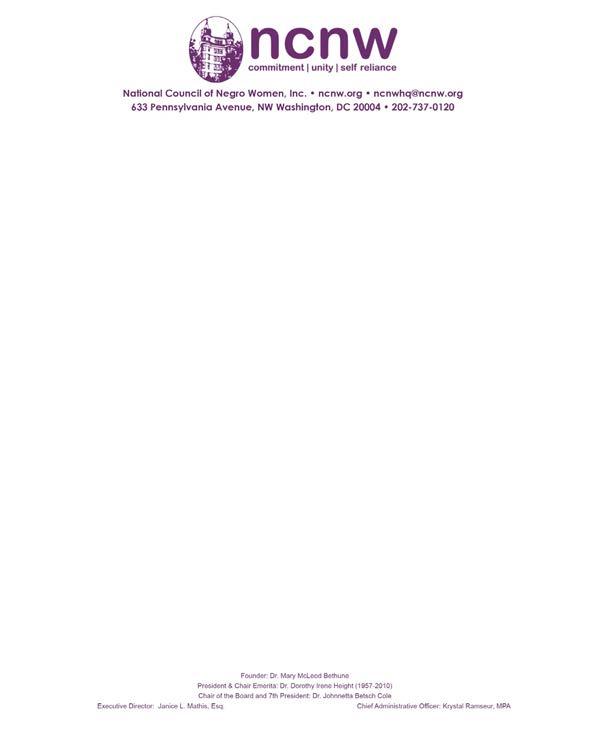






The purpose:
The main function of a poster is to capture a moving audience with a message. When designing a poster, plan its design carefully. You will have a short amount of time to attract and hold your readers attention. Think about the one aspect of the information that must convey the message and plan your design around that.
The Main Elements of Poster Design
• Have type large enough to be viewed to 3-5 times your format width.
• Have a simple and clear layout so your reader knows where to find the information.
• Include all important information such as date, time, location, contact name and telephone number.
• Have dominate elements such as a headline or image that will quickly catch your reader’s eye.
• Have the most important message emphasized by size, color, or value.
• Have art that is related to the message.
• Have the type and imagery arranged in a logical, functional sequence.
• Have bold, intense colors to enhance your message so that it can be easily seen from a distance.
Sisters Magazine is a vehicle to show ourselves and the world the major accomplishments and strides we are taking as an organization. We place emphasis on the four foci are the foundation of our mission. We share our knowledge on issues that are relevant to the Black woman and based in facts. Sisters Magazine is where we celebrate. We celebrate ourselves, our affiliates, our sections, and, of course, NCNW as a whole.
While the magazine comes out seasonally which usually coincides with an epic move forward that we are either leading or involved with, it may be themed around one of the four foci. We make it a point that all articles fall directly under the umbrellla of the four foci. Feature articles may change as we ripen the times and make our voices known. There are certain columns or updates that will be in every magazine. Not all we will be in every edition as we shift our focus, but here is a partial listing.
Submission Guidelines for State, Region & Section Community News
Section articles for Sisters Magazine are designed to highlight Section activities and not an individual. If photos are not submitted with the article, the word count should not exceed 100 words. If there are two photos, that count should be decreased by 50-75 words, depending on the photo dimensions. These counts are recommended to ensure that the images in the photos are recognizable.
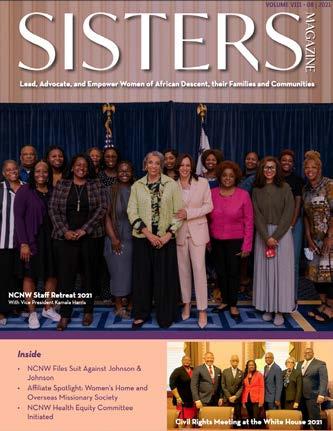

The recommended resolution for photos is 300dpi, however, anything above 150dpi will be accepted. The acceptable formats are JPG, PNG, or EPS (Keep in mind that photos copied or downloaded from Facebook pages tend to have a very low resolution), In turn, the quality of the photo is compromised. DO NOT PUT PHOTOS IN YOUR WORD DOCUMENT. You should submit separate files.
State & Section News - https://bit.ly/sistermagnews
Feature Articles - https://bit.ly/sistersmagfeature
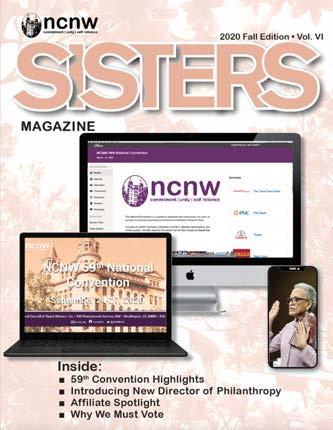
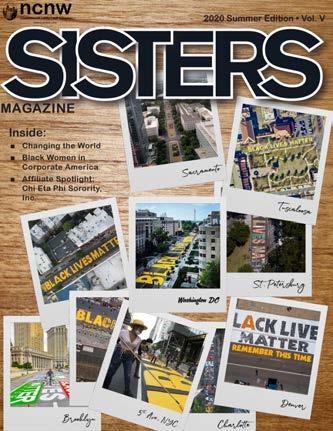

There are many different software tools out there to create whatever you wish. Some of them are professional and cost hundreds of dollars, some are under $20 or may have monthly $9.99 cost, and there are others that are completely free. Choose what best works for you and your end goals. They all can create professional looking still and motion graphics, photos, and videos. Here are just a few choices.
Adobe Creative Cloud is a set of applications and services from Adobe Inc. that gives subscribers access to a collection of software used for graphic design, video editing, web development, photography, along with a set of mobile applications and also some optional cloud services.

Canva is a graphic design platform, used to create social media graphics, presentations, posters, documents and other visual content. The app includes templates for users to use.

GIMP is a free and open-source raster (pixel) graphics editor (like photoshop) used for image manipulation and image editing, free-form drawing, transcoding between different image file formats, and more specialized tasks.

Vectr is free, simple and most intuitive vector graphics editing software. Free vector graphics software used to create graphics easily and intuitively.
The CleanPNG website is clean and easy to use. Simply pop your search criteria into the search box and you’ll find a variety of high definition images at your disposal, all with transparent backgrounds, downloadable for free.


Lumen5 is a video creation platform designed for brands and businesses to produce engaging video content for social posts, stories, and ads.
Descript is a collaborative audio/video editor that works like a doc. It includes transcription, a screen recorder, publishing, full multitrack editing, and some mind-bendingly useful AI tools.
As we have said, there are a lot out there. Here is a link to an excel file which might make it easy for you to find what you wish you use. https://bit.ly/techwebtools










Social media is a computer-based technology that allows the sharing of ideas, thoughts, and information through the building of virtual networks and communities. By design, social media is Internet-based and gives users quick electronic communication of content.
















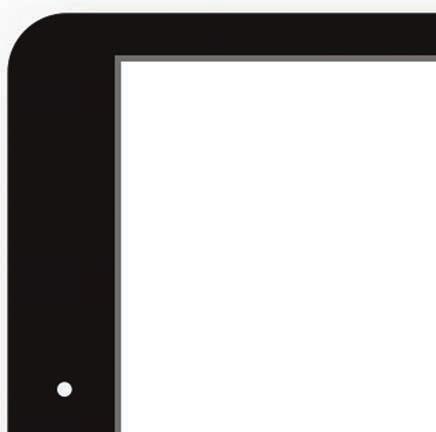
• Facebook is a free social networking site that makes it easy for you to connect and share with family and friends online.
• Facebook allows you to send messages and post status updates to keep in touch with friends and family. You can also share different types of content, like photos and links.
• Anyone over the age of 13 with a valid email address could join Facebook.
• Facebook is the world’s largest social network, with more than 1 billion users worldwide.
• “FB” is short for Facebook

• Facebook is so popular, other websites have worked to integrate Facebook. This means you can use a single Facebook account to sign into different services across the Web.
• Instagram is a free social media platform for sharing photos and videos.

• You can take, edit, and publish visual content for your followers to interact with through likes, comments, and shares.
• People can upload photos or videos to Instagram and share them with their followers or with a select group of friends.
• You can also view, comment and like posts shared by your friends on Instagram
• “IG” is short for Instagram
• Twitter is a free social media platform for users to share their thoughts, news, information, photos, videos.
• Twitter is a ‘microblogging’ system that allows you to send and receive short posts called tweets

• Twitter supports a maximum of 280 characters of text or less.
• Twitter Profiles are (usually) public — anyone in the world can see what you write, unless you choose to make your profile private
• Twitter users follow other users. If you follow someone you can see their tweets in your twitter ‘timeline’. You can choose to follow people and organizations with similar academic and personal interests to you.
• You can create your own tweets or you can retweet information that has been tweeted by others. Retweeting means that information can be shared quickly and efficiently with a large number of people.
LinkedIn is an online platform that connects the world’s professionals. ... A complete LinkedIn profile will summarize your professional experience to your connections, current and future employers, and recruiters. Through your profile, you can showcase your professional life, milestones, skills and interests.

DOWNLOAD - DO NOT DELETE
Below is a link with “How To” guides and more indepth explanations of each social media platforms.
https://bit.ly/ncnwsocialmedia
Each platform has different features. Knowing them will make it easier to reach your audience. Also, they all do not format in the same way. Below is a quick guide to features and graphic sizes that should help.

Social media analytics is the process of gathering and analyzing data from social networks such as Facebook, Instagram, LinkedIn and Twitter. It is commonly used by marketers to track online conversations about products and companies. One author defined it as “the art and science of extracting valuable hidden insights from vast amounts of semi-structured and unstructured social media data to enable informed and insightful decision making.”
https://bit.ly/ncnwsocialmediaform

The power of NCNW will be shown in the analytics of 330 sections that have at least one form of social media. By gathering and combining this information, we have a powerful voice to affect change in our lifetime and the time of our children.
A social media aggregator is a tool that helps in discovering & curating content from social media platforms into a single feed and gives the option to display this feed across all marketing channels.
Most importantly, the social media aggregator tool helps in curating user-generated content for your brand that you can leverage in your marketing & promotion along with building trust, increase user engagement, uplift brand image, and grow conversion & sales with minimum investments.


Connecting:
You are invited to an event by a colleague, and you see someone that works at the local tv station, or they are introduced to you as the station manager of your favorite radio station. Would you introduce yourself and immediately start spouting off your resume and accomplishments? Probably not. Instead, you would get to know the other person with conversation and look for areas of interest, common ground, and show your interest in the event and what they are doing there. After, you might share your business card or find another way to connect again in the future.
We make introductions because, no matter our goals, working with people means building relationships. This also holds true when working with journalists, editors, and media managers.
Just as networking is a two-way street, the same goes for working with reporters. Even if you don’t have a story to pitch yet, you can still take steps to build a positive relationship with them. Later, when you’re ready to pitch, it will pay off tenfold.
Here are two ways you can start building media relationships today:
Building strong relationships with journalists starts with understanding their expertise or field of interest. Start by researching media outlets and their reporters and develop a media list (a media list is a database of names, numbers, phone numbers, email addresses and areas of interest) of local, regional, and national reporters that help you tell your story or promote your programs and events.
These might be traditional outlets and reporters who cover social justice and politics, human rights, education, or other topics that are in line with NCNW’s four foci. Look at past articles, tv stories they have covered, and their social media activity. It will help to identify the correct contact.
Remember not to ignore influencers, niche media outlets, which can be just as significant for connecting to your target audience. Also, follow their social media, as well as the outlets, because what they are covering for work and what interest them may be two different things and you can use that to your advantage.
Once you’ve lined up your media targets, all you have to do is send a quick email, and presto—you’re getting your five minutes of fame, right? Guess again. Reporters’ inboxes are constantly flooded with dozens of pitches, including many that are off topic.
A better option would to be to reach out before you’re asking for coverage, without an agenda. Pay attention to the reporter’s latest articles, and when you find a story or podcast you like, send a short but sincere note that lets them know how much you enjoyed it. Even something as simple as, “Hey Frances, I loved your story on preparing Gen Z women for the workplace. I passed it along to my NCNW section.
Journalists—who are stretched thin—will always appreciate a note of gratitude. In fact, they’ll often respond! Journalists can quickly detect an unsolicited pitch, but if they reply to your positive comment, it’s a good opportunity to share a sentence or two about your section is doing and let them know you’re available if they ever wish to follow up.
The outreach in step 2 may nor may not earn you an opportunity on its own, but either way, you’re fostering a positive relationship with the reporter with each touchpoint. When the time comes that you do have a pitch to share, the journalist will already have a sense of who you are and is likely to recognize your name in their inbox. This can go a long way toward earning coverage!
As you are planning the event, forum, or news conference here are some things to keep in mind that can help get media coverage.
• Timeliness: Is your event focused on a topic that’s hot in the news right now? If not, can it be connected with an anniversary, holiday, or other event that jour nalists will be interested in?
• Visuals and audio: What would a TV camera see at your event? What can you do to make it visually interesting? What would a radio reporter capture?
• Scheduling: Will it be easy for media to make it? Typically, reporters will be available mid-morning and early afternoon. 5:00pm on weekdays is hard for print journalists because they’re finishing stories on deadlines. Are you competing with any big local events on the calendar? Your group will need to balance these considerations with other factors, of course, like finding a time that makes it easy for your members to turn out.
You have finally got their attention! Now make sure you keep it.
Make sure your media list is in good shape. A media list is your group’s running list of media contacts: four local TV affiliates, one or two local radio stations, the political reporters at your local newspapers, notable bloggers, and the AP Daybook. Consider Spanish-language media outlets too.
Write a media advisory. A media advisory is essentially an invitation for members of the press to attend your event. It’s shorter than a press release (one-two paragraphs) and covers the basics of your event: Who, What, Where, When and Why.

• Your media list should also include influencers
• Be sure there are no duplicate on your media list
• Keep your list updates, news professionals move around
• Follow individuals on your list’ social media
• Post your media advisory on your social media channels
Follow up, follow up, follow up. Sending your advisory to the right people with a compelling subject line is the first step. But, reporters’ inboxes get flooded with advisories every day. The critical next step is “pitching” your event—following up to make sure the right information gets seen by the right people at the right time. There’s a routine to this, if you can make time do it.
• TV newsrooms have two meetings a day to decide where cameras will be sent, one around 8:00am or 8:30am, and one around 3:00pm. The producers who make these decisions start with a “daybook,” or calendar of options, which is put together by the Assignment Desk at each station. Your goal is to make sure you’re in the daybook.
• Newspaper reporters generally have a big weekly meeting, and also run ideas for stories by their editors throughout the week. They need plenty of lead time in order to fit your event into a busy schedule.
Immediately after your event, send out photos and video and follow up. No matter how well prepared you are, sometimes not one reporter makes it to an event in person. You could have been bumped by a fire, a traffic accident, or the President. Send photos to reporters and photo editors at local papers and TV stations as soon as possible. If you have links to compelling, short videos, then consider sharing those as well. Reporters may be glad to have and promote these on their social media accounts, even if they don’t write a full story.
Post good photos and video to social media, tagging the participants, involved organizations, and the media. Consider posting a summary on a public Facebook page and sending that around to your list. Send out a news release (four-five short paragraphs featuring quotes from key participants/organizers) and post it on your website and social media. Send a news release around that includes the contact info of some of the event’s notable participants if they are available to give interviews as a follow up.
You will be surprised how many outlets pick up the story afterwards, especially if you have provided everything they need.
CONTACTS:
Angelo Greco (917) 499-2688 angelo@trillmulticultural.com Tkeban X.T. Jahannes (404) 944-1615 tjahannes@ncnw.org

WASHINGTON, D.C. – On Wednesday, September 15th the NCBCP Black Women’s Roundtable and National Council of Negro Women convened over 40 national civil rights, reproductive rights, women’s rights, labor and social justice organizations to partner for a Black Women Leaders & Allies Call to Action in support of Voting Rights & Reproductive Justice at the U. S. Supreme Court in a unified voice calling for the passage of the John Lewis Voting Rights Advancement Act and for Congress to swiftly move to protect the reproductive rights of women that is under attack in Texas and across the country.
The Call to Action included a National Call-In Day with the goal of mobilizing national and state-based partners ’members and networks to call their U. S. Senators to advocate for passage of federal voting rights reform and protection of women’s reproductive rights. For more information about the Black Women & Allies Call to Action go to BlackWomenTakeAction.org.
National Coalition on Black Civic Participation and Black Women ’s Roundtable Melanie L. Campbell, President and CEO of The National Coalition on Black Civic Participation and Convener, Black Women ’s Roundtable states, “Black women stand at the intersection of voting rights and reproductive justice. It is not an accident that we are standing at the steps of the U. S. Supreme Court right now in solidarity to demand our rights are protected. Historically, for Black people, we have always had to depend on federal protections of our voting rights through the Voting Rights Act. Further, as a woman, our reproductive rights have been protected through Roe v. Wade. Today, both our voting rights and reproductive rights are under attack and the U. S. Supreme Court has failed to protect those constitutionally protected rights. So, we have brought together the voting rights and reproductive movement to join forces to demand the U. S. Congress do their jobs to protect our rights now!”
National Council of Negro Women


It is time for women and people of goodwill everywhere who believe in the promise of this nation to stand up for democracy. Elected officials must be held accountable to the will of the American people - a majority of whom oppose voter suppression and support a woman's right to choose. We cannot preserve what is best about America by caving in to a misguided minority, no matter how vocal they are.” Janice L. Mathis, Esq, Executive Director of The National Council of Negro Women.
National Women ’s Law Center
“It is hardly a coincidence that the same politicians trying to recreate the gender roles of the 1950s are also trying to recreate the voting restrictions of the 1950s. Avoiding accountability at the ballot box emboldens them to pass such extreme and unpopular restrictions on abortion like SB8, and a healthy, participatory democracy is our greatest shield against these assaults on our collective freedom. With such an unprecedented campaign to force our country backwards, it is incumbent for Congress to take immediate and swift action to defend our access to abortion and the ballot.”
Fatima Goss Graves, President and CEO of the National Women ’s Law Center
at Steps of U. S. Supreme Court in Solidarity To Urge Congress to Pass Voting Rights Legislation and Protect
1. Journalist, reporters, talk show host like true stories.
2. Is your story for television, radio, and/or print? Consider public radio and public television as well. Most televisions now have segments of their daily news and weekend programming that focus on the community or soft news information.
3. Keep your pitch short and in conversation, in an email, or a text message (Look up elevator speech).
4. Be specific, tell the newsroom or reporter why your story would be of interest to viewers, listeners, readers.
5. Let them know the story is time-sensitive and you plan to follow up with them.
6. Don’t write, email, or text your opinion. Save that for the actual interview, quote, or sound bite.
7. Feel free to send attachments but also within the email, write that you have attached pictures, a document, etc.
A public service announcement (PSA) is a message in the public interest disseminated by the media without charge to raise public awareness and change behavior. There is no law requiring broadcasters to air PSAs anymore, but they continue to do so when they feel that the message brings a benefit to the community.
A great PSA should spark a conversation. When the original anti-drug ads aired, they brought the topic of drug abuse to the forefront. This created an opportunity for parents, teachers and other influential community members to talk to kids about drug abuse. In fact, we’re still talking about these ads. Recently, the Partnership for DrugFree Kids revived the “Your Brain On Drugs” campaign with the hopes of encouraging today’s parents to talk to their children about drug abuse. The new version of the ad is impactful because it goes beyond the “got any questions” line and shows that kids may actually have a lot of questions. This provides parents a framework for starting the conversation
The goal of any PSA should be to raise awareness of an issue and call people to action. Beginning with what you want your audience to talk about is a good starting point for any communications campaign. Below are some tips to keep in mind when developing PSAs.
• Short and Simple: Like all communication in the digital age, concise and short is best. Capture your audience – and keep their attention – with phrases and images.
• Call to Action: Each PSA needs a call to action at the end. What do you want your target audience to do? Join an organization? Sign a petition? Volunteer? Make it clear to the audience what is being asked of them.
• Visual Elements: “A picture is worth a thousand words?” Let images tell the story and let the words support what your audience is experiencing. This should also be a rule of thumb when developing a PSA unless it is radio, but then paint a picture in the listeners mind.
• Radio & TV Broadcast Versions: Since PSAs are also regularly aired on radio stations, be sure to create both radio and TV broadcast versions for maximum impact.
• Duration: Most broadcast networks prefer 10- and 15-second spots. Networks need to fill time in between paid commercials/content and this PSAs are the perfect tool for filling that space.
• Make it Timely: If there are elements to a PSA that could become dated, be sure to cover that in your voiceover. Have a separate recording that could be switched out, as needed, in order to keep the PSA as relevant as possible.